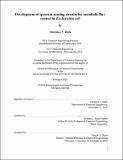Development of quorum-sensing circuits for metabolic flux control in Escherichia coli
Author(s)
Dinh, Christina V.
DownloadThesis PDF (9.586Mb)
Advisor
Jones Prather, Kristala L.
Terms of use
Metadata
Show full item recordAbstract
Metabolic engineering seeks to reprogram microbial cells to efficiently produce value-added chemicals. Traditionally, this is achieved by overexpressing the production pathway and/or knocking out competing endogenous pathways. However, limitations in some pathways are more effectively addressed through dynamic metabolic flux control to favor different objectives over the course of the fermentation. This thesis aims to develop autonomous and pathway-independent regulation tools that can be applied to controlling metabolic fluxes in these contexts to improve production. To this end, quorum-sensing (QS)-based circuits were constructed, characterized, and applied to regulating metabolic fluxes in a cell-density-dependent manner. The first tool is a bifunctional QS circuit in which each control module regulates transcription under circuits derived from different QS systems. Characterization showed that the switching dynamics of both circuits can be tuned by varying the expression level of circuit components. To address major limitations in the naringenin and salicylic acid pathways, one module was used to delay transcription of key heterologous genes to overcome enzyme inhibition and growth burden while the second module controlled expression of CRISPRi components to silence competing endogenous pathways. Application of these regulation schemes resulted in significant production improvements in both pathways. Especially when aiming to dynamically down-regulate enzyme activity, post-translational control can offer faster response dynamics. To develop a post-translational control tool, expression of a protease linker was regulated under a QS circuit, resulting in selective degradation of tagged enzymes. This circuit was applied to regulating phosphofructokinase (Pfk:) levels with the ultimate goal of dynamic composition control in co-culture fermentations. Application of this control circuit in a naringenin-producing co-culture system resulted in improved composition profiles, which benefited production. Finally, a second post-translational control system that co-localizes proteins in response to cell-density changes was constructed and characterized. Such a system can be applied to actuate changes in reaction rates with minimal dependence on host cell machinery. Overall, this work developed QS-based circuits and showed they can be powerful tools for addressing key limitations in microbial syntheses.
Date issued
2020-02Department
Massachusetts Institute of Technology. Department of Chemical EngineeringPublisher
Massachusetts Institute of Technology